It looks like you're using an Ad Blocker.
Please white-list or disable AboveTopSecret.com in your ad-blocking tool.
Thank you.
Some features of ATS will be disabled while you continue to use an ad-blocker.
share:
I want to examine the basis here for the Masonic-Kabbalistic-Judaic tradition of the 'Stairway to Sirius' or 'Jacobs Ladder', it is a tradition indeed
of great antiquity and one of enormous influence but my interest is how well it has translated over the years and is todays interpretation distorted
viewpoint.
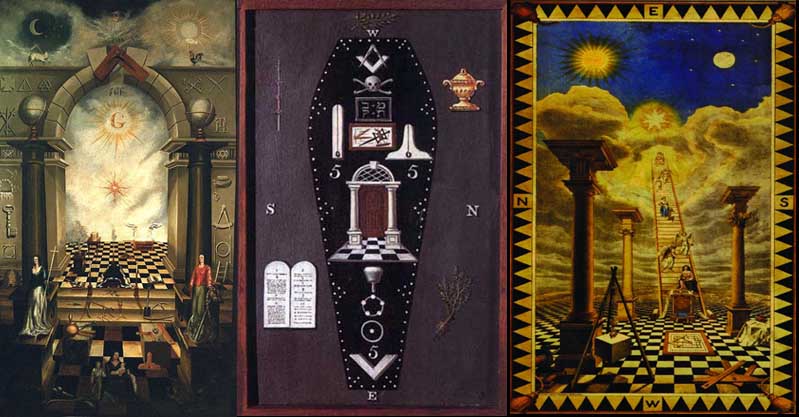

I follow here the assumption that from the time of John Dee and probably earlier the esoteric interests of the early Masonic Lodges were largely based upon Judaic Kabbalistic teachings, that the idealized model for the Lodge was that of Solomon's Temple.
The basis for the Hebrew Temple and indeed the Tabernacle in the Wilderness was that of the Celestial Place of establishment within the waters of chaos as represented by the square of Pegasus, a place of first ordering that in earliest representations from Dilmun could be seen as a grid, sacred to Enki or Ea-Yah correlating to the Abzu shrine, and this then also the basis for the chequer board pattern of the Lodge.
To understand what basis there could be for an interest extending upward toward Sirius from this ground plan based upon Pegasus i had to consider the Mysteries of Dilmun, that earliest version of Paradise, were it could be seen iconography indicated correspondence to the myth of Enki and Ninhursaga whereby Enki through five successive generations of impregnating his own daughters arrived at Uttu the spider Goddess that represented Canis Major and Sirius, this was the basis of the axis toward Sirius.
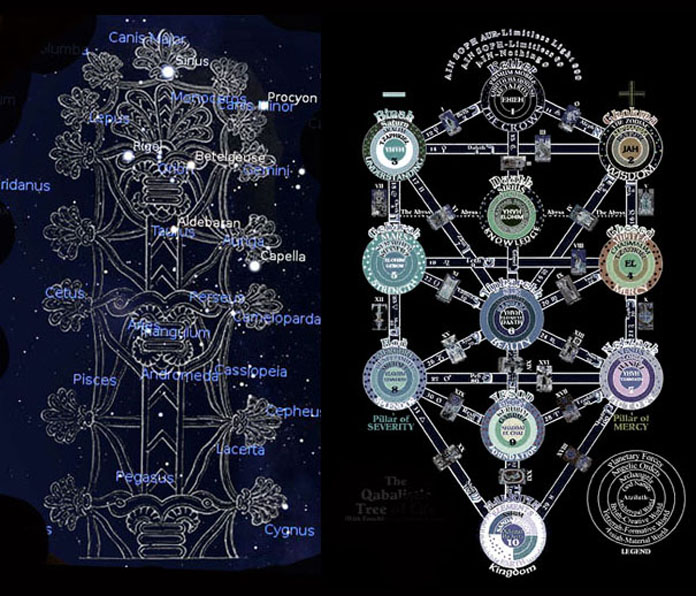
In considering the Sumeria myth and the five subsequent generations from Nintur-Ninnisig- Ninkura-Ninimma to Uttu one does find numeric correspondence in the upward progression of the tree of Life and it might be assumed associated constellations in the astral configuartion, with Enki it is always about sex and the generation of organic life and the five Goddesses will relate to birthing ;
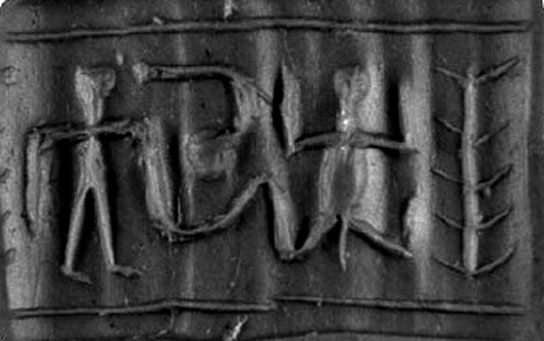
In many cultures Canis Major is seen as a birth Goddess very similar to the Dilmun carving above showinf Enko and the relationship between semen and water and the five stage tree of life, there is also seen in the myth the inter-relationship between flower and fauna, in that Enki's seed is recovered from Uttu. eight plants derived from it, Enki eats the plants and then eight Deities are recovered from his body, so at the level of DNA it's all the same, but the tree of Life was just about that and Nin=Ti the Lady of Life represented by the crescent rib was one of those eight children born;
So one begins to see a marked difference in the Sumerian associations with the Tree of Life and the teachings of the Kabbalah and it's claim to represent all aspects of Divinity through the eleven nodes and their mystical three way interpretation of the 33 Masonic Degrees, at the summit they posit the Crown of Divine Consciousness the Sumerians a Spider Goddess, yet they both follow the same direction...
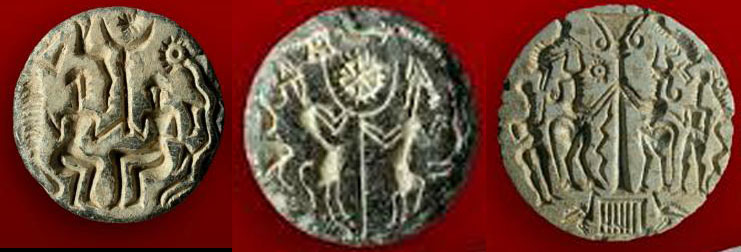
Looking at the greater picture the Free Masons did consider this central axis as relating to Wisdom, after the likes of the Goddess Isis or Athena or Neith, and as Uttu was a Goddess of weaving just like Athena and Neith then one finds a version from the Classical Period has replaced an earlier, and the spider Goddess herself in Sumeria was quickly replaced by Canis Major being seen to represent an arrow and bow pointing directly toward Taurus, the same symbol as for the Goddess Neith, but the old tradition of the huntress, of weaving of patterns and fate and destinies had been lost, she had though gained a dog as companion.
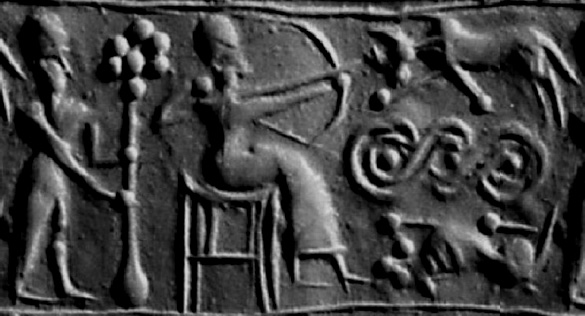
It is interesting to trace the development of the Tree of Life iconography, one can even see how a spider transforms into the winged disk, where the spider version is seen bottom right

So one sees the animals relating to the constellations Andromeda the stag, Aires the ram, Perseus the Panther, representations of the eight plants sourced from the myth and also the symbolism of the five stages in terms of the filial of the date palm tree, symbol of Enki, though generally the interest in the axis is only to the extent of Perseus, as Taurus represented the portal and place of ordering of the Underworld, a different sort of stage and from there toward the highest level.
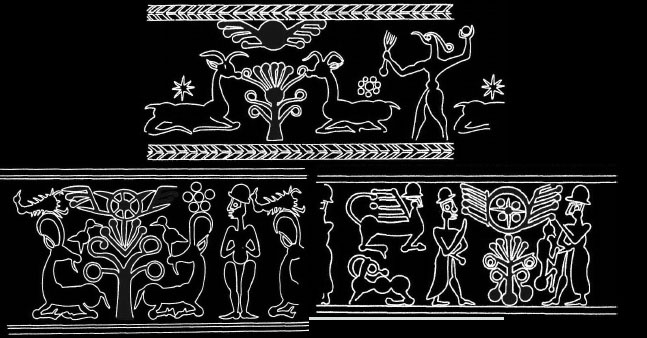
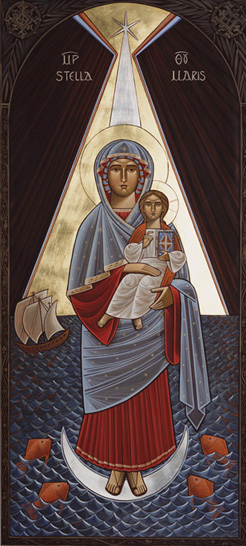 In conclusion then i have to say that Celestial axis is a thing of great wonder
and beauty, you'd have to be in near Earth orbit to ever see it as it can't be viewed from the ground in any such way, but even if entirely down to
conjecture, wonderful.
In conclusion then i have to say that Celestial axis is a thing of great wonder
and beauty, you'd have to be in near Earth orbit to ever see it as it can't be viewed from the ground in any such way, but even if entirely down to
conjecture, wonderful.
Of course one can develop a wisdom tradition relating to the various constellations along it's path, as the Kabbalists appear to have done and look at those in three different ways if one so chooses, there's just no evidence the Sumerians ever did though and certainly they wouldn't have related it to all aspects of Divinity, as it relates only to the cult of Enki and his off-spring.
Of the eight it gave birth to one was destined to become Lord of Dilmun and the other of Magan, in Christian tradition relating to Sirius as Stella Maris or Star of the Waters this is perhaps recalled, a Lord of Paradise...any thoughts?

Kabbalah originally developed entirely within the realm of Jewish thought, and kabbalists often use classical Jewish sources to explain and demonstrate its esoteric teachings. These teachings are held by followers in Judaism to define the inner meaning of both the Hebrew Bible and traditional Rabbinic literature and their formerly concealed transmitted dimension, as well as to explain the significance of Jewish religious observances
Traditional practitioners believe its earliest origins pre-date world religions, forming the primordial blueprint for Creation's philosophies, religions, sciences, arts, and political systems. Historically, Kabbalah emerged, after earlier forms of Jewish mysticism, in 12th- to 13th-century Southern France and Spain

I follow here the assumption that from the time of John Dee and probably earlier the esoteric interests of the early Masonic Lodges were largely based upon Judaic Kabbalistic teachings, that the idealized model for the Lodge was that of Solomon's Temple.
The basis for the Hebrew Temple and indeed the Tabernacle in the Wilderness was that of the Celestial Place of establishment within the waters of chaos as represented by the square of Pegasus, a place of first ordering that in earliest representations from Dilmun could be seen as a grid, sacred to Enki or Ea-Yah correlating to the Abzu shrine, and this then also the basis for the chequer board pattern of the Lodge.
To understand what basis there could be for an interest extending upward toward Sirius from this ground plan based upon Pegasus i had to consider the Mysteries of Dilmun, that earliest version of Paradise, were it could be seen iconography indicated correspondence to the myth of Enki and Ninhursaga whereby Enki through five successive generations of impregnating his own daughters arrived at Uttu the spider Goddess that represented Canis Major and Sirius, this was the basis of the axis toward Sirius.

In considering the Sumeria myth and the five subsequent generations from Nintur-Ninnisig- Ninkura-Ninimma to Uttu one does find numeric correspondence in the upward progression of the tree of Life and it might be assumed associated constellations in the astral configuartion, with Enki it is always about sex and the generation of organic life and the five Goddesses will relate to birthing ;

When Mother Nintur sat upon the throne-dais on the holy seat of joy, the seat from which she has made everything numerous, it was then that the highest divine powers, which are golden, the glory of the numerous people -- the en priesthood and the kingship -- were created for Enlil.
In many cultures Canis Major is seen as a birth Goddess very similar to the Dilmun carving above showinf Enko and the relationship between semen and water and the five stage tree of life, there is also seen in the myth the inter-relationship between flower and fauna, in that Enki's seed is recovered from Uttu. eight plants derived from it, Enki eats the plants and then eight Deities are recovered from his body, so at the level of DNA it's all the same, but the tree of Life was just about that and Nin=Ti the Lady of Life represented by the crescent rib was one of those eight children born;
Uttu in Sumerian mythology is the goddess of weaving and clothing. She is both the child of Enki and Ninkur, and she bears seven new child/trees from Enki, the eighth being the Ti (Tree of "Life", associated with the "Rib"). When Enki then ate Uttu's children, Ninhursag cursed him with eight wounds and disappears. Uttu in Sumerian means "the woven" and she was illustrated as a spider in a web
So one begins to see a marked difference in the Sumerian associations with the Tree of Life and the teachings of the Kabbalah and it's claim to represent all aspects of Divinity through the eleven nodes and their mystical three way interpretation of the 33 Masonic Degrees, at the summit they posit the Crown of Divine Consciousness the Sumerians a Spider Goddess, yet they both follow the same direction...

Looking at the greater picture the Free Masons did consider this central axis as relating to Wisdom, after the likes of the Goddess Isis or Athena or Neith, and as Uttu was a Goddess of weaving just like Athena and Neith then one finds a version from the Classical Period has replaced an earlier, and the spider Goddess herself in Sumeria was quickly replaced by Canis Major being seen to represent an arrow and bow pointing directly toward Taurus, the same symbol as for the Goddess Neith, but the old tradition of the huntress, of weaving of patterns and fate and destinies had been lost, she had though gained a dog as companion.

It is interesting to trace the development of the Tree of Life iconography, one can even see how a spider transforms into the winged disk, where the spider version is seen bottom right

So one sees the animals relating to the constellations Andromeda the stag, Aires the ram, Perseus the Panther, representations of the eight plants sourced from the myth and also the symbolism of the five stages in terms of the filial of the date palm tree, symbol of Enki, though generally the interest in the axis is only to the extent of Perseus, as Taurus represented the portal and place of ordering of the Underworld, a different sort of stage and from there toward the highest level.

 In conclusion then i have to say that Celestial axis is a thing of great wonder
and beauty, you'd have to be in near Earth orbit to ever see it as it can't be viewed from the ground in any such way, but even if entirely down to
conjecture, wonderful.
In conclusion then i have to say that Celestial axis is a thing of great wonder
and beauty, you'd have to be in near Earth orbit to ever see it as it can't be viewed from the ground in any such way, but even if entirely down to
conjecture, wonderful. Of course one can develop a wisdom tradition relating to the various constellations along it's path, as the Kabbalists appear to have done and look at those in three different ways if one so chooses, there's just no evidence the Sumerians ever did though and certainly they wouldn't have related it to all aspects of Divinity, as it relates only to the cult of Enki and his off-spring.
Of the eight it gave birth to one was destined to become Lord of Dilmun and the other of Magan, in Christian tradition relating to Sirius as Stella Maris or Star of the Waters this is perhaps recalled, a Lord of Paradise...any thoughts?
"For the little ones to whom I have given birth may rewards not be lacking. Ab-u shall become king of the grasses, Ninsikila shall become lord of Magan, Ningiriutud shall marry Ninazu, Ninkasi shall be what satisfies the heart, Nazi shall marry Nindara, Azimua shall marry Ninĝišzida, Ninti shall become the lady of the month, and Ensag shall become lord of Dilmun."
edit on Kam831237vAmerica/ChicagoTuesday2631 by Kantzveldt because: (no reason given)
a reply to: Kantzveldt
Hi Kantzveldt, yet another fascinating thread. What interests me is that for many ancient peoples the underworld or other world was beneath the land and for others it was up in the sky.
Are we looking at the sky believers being the sun worshipping peoples and the luna their afterlife beneath the earth?
I find the Kabbalistic view on the tree of life of interest but not world changing. Seeing you historically link it back to Enlil at the time of the Sumerians, its a borrowed concept that has been tweeked to suit the Jewish mindset of the time when the Kaballa was put together, but when you look at the Babylonians, Egyptians and Sumerians their worlds were well established and wide reaching and especially the Babylonians, lived their lives in accord with the cosmos. whilst the Jewish was firmly placed on survival wherever they wandered. It seems that Christ may have used Geomancy from what little we can gleam of his preferences.
Hi Kantzveldt, yet another fascinating thread. What interests me is that for many ancient peoples the underworld or other world was beneath the land and for others it was up in the sky.
Are we looking at the sky believers being the sun worshipping peoples and the luna their afterlife beneath the earth?
I find the Kabbalistic view on the tree of life of interest but not world changing. Seeing you historically link it back to Enlil at the time of the Sumerians, its a borrowed concept that has been tweeked to suit the Jewish mindset of the time when the Kaballa was put together, but when you look at the Babylonians, Egyptians and Sumerians their worlds were well established and wide reaching and especially the Babylonians, lived their lives in accord with the cosmos. whilst the Jewish was firmly placed on survival wherever they wandered. It seems that Christ may have used Geomancy from what little we can gleam of his preferences.
Pretty interesting read. You got my S&F.
Reading about Uttu being a seamstress, reminded me of the three sister of fate, or "The Moirai". Albeit, the three are different to that of the one weaving God from Sumerian text. Also, there are many variation relating to other cultural mythologies, never minding the Greek view on them being Godesses, or even being more powerful then the Olympians.
I do wonder about how close ancient Jews were to the ancient Greeks sometimes. Excluding the fact that Rome had their ordeals with Hebrews.
Reading about Uttu being a seamstress, reminded me of the three sister of fate, or "The Moirai". Albeit, the three are different to that of the one weaving God from Sumerian text. Also, there are many variation relating to other cultural mythologies, never minding the Greek view on them being Godesses, or even being more powerful then the Olympians.
I do wonder about how close ancient Jews were to the ancient Greeks sometimes. Excluding the fact that Rome had their ordeals with Hebrews.
a reply to: Shiloh7
I think you always find astral symbolism even for quite mundane things, giving the sense that there is always a greater Celestial archetype involved and that Earth related activities therefore have correspondence in the Heavens. Thus for example the Abzu shrine had it's Heavenly basis in the square of Pegasus, as a place of first emergence of land from the waters, that could be ordered and divided, in Earthly terms this was just a field measure.
The Underworld was seen were one would expect to find it, down beneath the Earth, but in also associating the Underworld with Taurus as the portal in the West were the ecliptic and galactic planes intercept they were perhaps looking toward this expression of brute will and Life force to even overcome this, it had sacrificial function but could be expected to rise again in the re-invigoration of the land.
I find the Kabbalistic version of the Tree of Life tedious and pretentious, the Enki version far more enigmatic...
a reply to: Specimen
Generally also the Fates are seen at the roots of the Sacred Tree scheming away in the darkness in Northern European tradition, but in Sumerian lore the spider Goddess is right there at the top, and it is Enki that is generating organic life from the base.
The probable reason for this is the early Sumerian role of Ninshubur as Orion were she is represented as the seated woman, here she will be understood as weaving fate upon the loom of Uttu/Canis Major.

Her capacity to do so will relate to her being the First Minister of Anu as the Bull of Heaven Taurus and Inanna as the Pleiades, thus through consultation with the Highest Powers the pattern is woven, in the manner which she orchestrates activities on Earth.
I think you always find astral symbolism even for quite mundane things, giving the sense that there is always a greater Celestial archetype involved and that Earth related activities therefore have correspondence in the Heavens. Thus for example the Abzu shrine had it's Heavenly basis in the square of Pegasus, as a place of first emergence of land from the waters, that could be ordered and divided, in Earthly terms this was just a field measure.
The Underworld was seen were one would expect to find it, down beneath the Earth, but in also associating the Underworld with Taurus as the portal in the West were the ecliptic and galactic planes intercept they were perhaps looking toward this expression of brute will and Life force to even overcome this, it had sacrificial function but could be expected to rise again in the re-invigoration of the land.
I find the Kabbalistic version of the Tree of Life tedious and pretentious, the Enki version far more enigmatic...
a reply to: Specimen
Generally also the Fates are seen at the roots of the Sacred Tree scheming away in the darkness in Northern European tradition, but in Sumerian lore the spider Goddess is right there at the top, and it is Enki that is generating organic life from the base.
The probable reason for this is the early Sumerian role of Ninshubur as Orion were she is represented as the seated woman, here she will be understood as weaving fate upon the loom of Uttu/Canis Major.

Her capacity to do so will relate to her being the First Minister of Anu as the Bull of Heaven Taurus and Inanna as the Pleiades, thus through consultation with the Highest Powers the pattern is woven, in the manner which she orchestrates activities on Earth.
edit on Kpm831237vAmerica/ChicagoTuesday2631 by Kantzveldt because: (no reason given)
originally posted by: Kantzveldt
I want to examine the basis here for the Masonic-Kabbalistic-Judaic tradition of the 'Stairway to Sirius' or 'Jacobs Ladder', it is a tradition indeed of great antiquity and one of enormous influence but my interest is how well it has translated over the years and is todays interpretation distorted viewpoint.
Very interesting post!
Jacob's ladder does indeed feature prominently in Freemasonry:
Figuratively, the roof or covering of a Freemason's lodge represents Heaven. It can be reached with the assistance of Jacob's ladder, which has many rungs, each rung denoting a different moral virtue, of which three of the most important rungs are faith, hope and charity.
a reply to: Saurus
I was about to post something about Jacobs Ladder being the path to Heaven, but as usual, Saurus has said it much prettier than I could have. (He is a much better speacher)
I believe all paths that involve an afterlife have a reference to the "above" as it's the single most incredible thing we can see and have no means of comprehending. We can look at the stars, the sun, the moon, and have no understanding of the vastness of what is beyond what we can see. Heaven must be among all of that. (or whatever afterlife you wish)
Great thread topic.
I was about to post something about Jacobs Ladder being the path to Heaven, but as usual, Saurus has said it much prettier than I could have. (He is a much better speacher)
I believe all paths that involve an afterlife have a reference to the "above" as it's the single most incredible thing we can see and have no means of comprehending. We can look at the stars, the sun, the moon, and have no understanding of the vastness of what is beyond what we can see. Heaven must be among all of that. (or whatever afterlife you wish)
Great thread topic.
It may be interesting to note that the constellation Virgo is often prominently displayed on the walls of many Lodges. Virgo, like many of the
symbols within masonry, has layered meanings. The most gorgeous virgin among the constellations, holding a spear of wheat marked by the brilliant
star Spica.
In Egyption mythology Virgo is represented by Isis, and instead of Wheat, she is holding 3 ears of corn also marked by Spica. Corn was one of the craft's wages, and represents a great bounty or plenty. Another cool piece of symbolism that can be related to masonry is that Spica, Danebola (in Leo) and the beautiful Arcturus (in Bootes) form a perfect equilateral triangle.
Finally, and of great importance to masonic tradition, in the Hebrew tradition Virgo is represented by Naphtali. A prominent figure within Freemasonry is the widow's son, of the tribe of Naphtali whose standard was a tree bearing goodly and productive branches
Refferenced from "Stellar Theology and Masonry" -- Robert H. Brown
In Egyption mythology Virgo is represented by Isis, and instead of Wheat, she is holding 3 ears of corn also marked by Spica. Corn was one of the craft's wages, and represents a great bounty or plenty. Another cool piece of symbolism that can be related to masonry is that Spica, Danebola (in Leo) and the beautiful Arcturus (in Bootes) form a perfect equilateral triangle.
Finally, and of great importance to masonic tradition, in the Hebrew tradition Virgo is represented by Naphtali. A prominent figure within Freemasonry is the widow's son, of the tribe of Naphtali whose standard was a tree bearing goodly and productive branches
Refferenced from "Stellar Theology and Masonry" -- Robert H. Brown
a reply to: Saurus
The Sumerian celestial axis involved here involves seven constellations from Pegasus-Andromeda-Aires-Perseus-Taurus-Orion-Canis Major, though as i mentioned in the myth this involved five stages of pro-creation to arrive at the uppermost point.
There isn't any evidence they saw it in terms of a ladder or stairway but always as the Tree of Life, though in some examples there appears some sort of diminishing perspective reminiscent of the pathway to Sirius tradition.
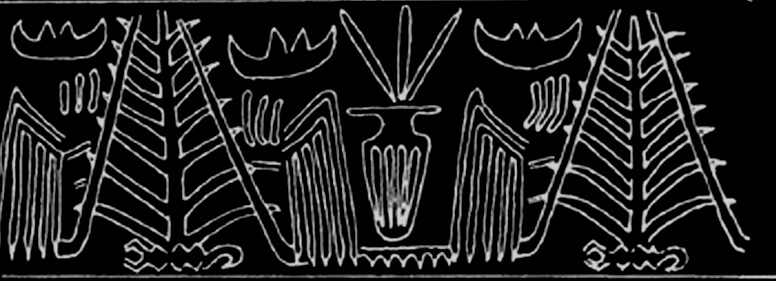
a reply to: network dude
It's perhaps interesting to note that in the tradition related to Enki life will always relate to organic-physical life, not spiritual, i think the tradition of there being an entrance into the Underworld at Taurus, and that place being associated with a grid as a place of established order, the same as Pegasus, represented something of a challenge along that progression upward, but not an insurmountable one.
The traditions of the healing Goddesses associated with Sirius in Sumeria, Bau and Gula and Ninisin and Ninsumen all had traditions of conception through artificial insemination, similar to that of Isis, and in the Uttu myth the semen of Enki is removed from her to create first plants and then after Enki ingests these eight Deities, so very unusual considerations on the methods of pro-creation, and as they're at the top of the tree arguably suggesting the most advanced.
The Sumerian celestial axis involved here involves seven constellations from Pegasus-Andromeda-Aires-Perseus-Taurus-Orion-Canis Major, though as i mentioned in the myth this involved five stages of pro-creation to arrive at the uppermost point.
There isn't any evidence they saw it in terms of a ladder or stairway but always as the Tree of Life, though in some examples there appears some sort of diminishing perspective reminiscent of the pathway to Sirius tradition.

a reply to: network dude
It's perhaps interesting to note that in the tradition related to Enki life will always relate to organic-physical life, not spiritual, i think the tradition of there being an entrance into the Underworld at Taurus, and that place being associated with a grid as a place of established order, the same as Pegasus, represented something of a challenge along that progression upward, but not an insurmountable one.
The traditions of the healing Goddesses associated with Sirius in Sumeria, Bau and Gula and Ninisin and Ninsumen all had traditions of conception through artificial insemination, similar to that of Isis, and in the Uttu myth the semen of Enki is removed from her to create first plants and then after Enki ingests these eight Deities, so very unusual considerations on the methods of pro-creation, and as they're at the top of the tree arguably suggesting the most advanced.
edit on Kpm831237vAmerica/ChicagoTuesday2631 by Kantzveldt because: (no reason given)
originally posted by: Kantzveldt
Of course one can develop a wisdom tradition relating to the various constellations along it's path, as the Kabbalists appear to have done and look at those in three different ways if one so chooses, there's just no evidence the Sumerians ever did though and certainly they wouldn't have related it to all aspects of Divinity, as it relates only to the cult of Enki and his off-spring.
I am of the opinion that the Kabbalist tradition is entirely derivative, created between the 11th and 12th centuries as a retrospective response to the mysticism that was brought back with the crusaders. It appears seemingly out of nowhere in and around Prague at that time, and as you say, it is somewhat pretentious not to mention contrived. That is not to say that there was a complete absence of mysticism in the Judaic tradition up to that point, just not in that shape and form.
In terms of the Sumerian 'wisdom tradition' in that context and particularly in relation to Freemasonry, it is much more useful to make the comparison directly with the Operative craft rather than the Speculative. I don't know if you have read Wayne Horowitz's Mesopotamian Cosmic Geography, but he does a stellar job of translating and contextualising the extant examples of astrolabes of the region over the entire period. The astrolabes can be considered the core structure of the Mesopotamian 'life', their accuracy being the difference between life and death for the people under their governance, in that capacity we can see the 'priests' that drew them up, mapping out the stars to determine the seasonal changes, as a direct development of the shaman as rainmaker/flood stopper, seeking to attain control of nature, order from chaos. The stars could predict even subtle changes in the weather systems if correctly mapped and observed, and the complexity with which they did so, by the various paths that the stars followed at any given time were predictive of the seasons and aided in the planning of the agricultural year. The Mesopotamian priests were hugely successful in doing this, we can still learn from them in that respect, the region after all, unlike other civilisations such as the Maya, was not brought down by unexpected and seemingly random weather cycles, it was the irrigation system and salination of the soil that got them.
If you then relate that to the Operative Masons, where the Masons went mathematical learning followed and the speculation became an adherence to that. The Operative craft used divine or universal ordering to create their great works, which is why they were sequestered by the church, just as the priests of Mesopotamia kept the astrolabes to themselves to ensure their own survival and importance. How that then filters down in the form of a belief system is dependent on the customs and superstitions of the people under rule, and is usually syncretic in nature, subject to change and revision. Speculative Masonry relates more to the contemplation of the implications of that order, if you have read The Invisible College by Brian Lomas you will have some idea though of how that still draws upon the origins of Mesopotamian astronomy. Another good study, on that note, is Francesca Rochberg's Heavenly Writing; Divination Horoscopy and Astronomy in Mesoptomian Culture, where again you see how mathematics and divine order was used in terms of the laws of probability. I suspect that many of the seals are actually personal horoscopes and that is how they identified themselves both in terms of their personal lives and in trade. You also find that probability is used in a regimented fashion for divination, and that later those divination tools are adapted for use in gambling and race games such as the Royal Game of Ur.

originally posted by: KilgoreTrout
originally posted by: Kantzveldt
Of course one can develop a wisdom tradition relating to the various constellations along it's path, as the Kabbalists appear to have done and look at those in three different ways if one so chooses, there's just no evidence the Sumerians ever did though and certainly they wouldn't have related it to all aspects of Divinity, as it relates only to the cult of Enki and his off-spring.
I am of the opinion that the Kabbalist tradition is entirely derivative, created between the 11th and 12th centuries as a retrospective response to the mysticism that was brought back with the crusaders. It appears seemingly out of nowhere in and around Prague at that time, and as you say, it is somewhat pretentious not to mention contrived. That is not to say that there was a complete absence of mysticism in the Judaic tradition up to that point, just not in that shape and form.
In terms of the Sumerian 'wisdom tradition' in that context and particularly in relation to Freemasonry, it is much more useful to make the comparison directly with the Operative craft rather than the Speculative. I don't know if you have read Wayne Horowitz's Mesopotamian Cosmic Geography, but he does a stellar job of translating and contextualising the extant examples of astrolabes of the region over the entire period. The astrolabes can be considered the core structure of the Mesopotamian 'life', their accuracy being the difference between life and death for the people under their governance, in that capacity we can see the 'priests' that drew them up, mapping out the stars to determine the seasonal changes, as a direct development of the shaman as rainmaker/flood stopper, seeking to attain control of nature, order from chaos. The stars could predict even subtle changes in the weather systems if correctly mapped and observed, and the complexity with which they did so, by the various paths that the stars followed at any given time were predictive of the seasons and aided in the planning of the agricultural year. The Mesopotamian priests were hugely successful in doing this, we can still learn from them in that respect, the region after all, unlike other civilisations such as the Maya, was not brought down by unexpected and seemingly random weather cycles, it was the irrigation system and salination of the soil that got them.
If you then relate that to the Operative Masons, where the Masons went mathematical learning followed and the speculation became an adherence to that. The Operative craft used divine or universal ordering to create their great works, which is why they were sequestered by the church, just as the priests of Mesopotamia kept the astrolabes to themselves to ensure their own survival and importance. How that then filters down in the form of a belief system is dependent on the customs and superstitions of the people under rule, and is usually syncretic in nature, subject to change and revision. Speculative Masonry relates more to the contemplation of the implications of that order, if you have read The Invisible College by Brian Lomas you will have some idea though of how that still draws upon the origins of Mesopotamian astronomy. Another good study, on that note, is Francesca Rochberg's Heavenly Writing; Divination Horoscopy and Astronomy in Mesoptomian Culture, where again you see how mathematics and divine order was used in terms of the laws of probability. I suspect that many of the seals are actually personal horoscopes and that is how they identified themselves both in terms of their personal lives and in trade. You also find that probability is used in a regimented fashion for divination, and that later those divination tools are adapted for use in gambling and race games such as the Royal Game of Ur.
If it indeed was based on mysticism, then perhaps it was a prophecy and that leads me to the present day planning of a space elevator.
edit on 26-8-2014 by InTheLight because: (no reason given)
a reply to: InTheLight
If you like Or we could see it as an evolution of ideas and science from Mesopotamia to that potential future.
Obviously...
“Magic's just science that we don't understand yet.”
― Arthur C. Clarke
Imagination can be prophetic if welcomed by creative minds...so why the hell not
If you like Or we could see it as an evolution of ideas and science from Mesopotamia to that potential future.
Obviously...
“Magic's just science that we don't understand yet.”
― Arthur C. Clarke
Imagination can be prophetic if welcomed by creative minds...so why the hell not
originally posted by: KilgoreTrout
a reply to: InTheLight
If you like Or we could see it as an evolution of ideas and science from Mesopotamia to that potential future.
Obviously...
“Magic's just science that we don't understand yet.”
― Arthur C. Clarke
Imagination can be prophetic if welcomed by creative minds...so why the hell not
Indeed, why the hell not?
a reply to: KilgoreTrout
I do consider the Hebrews to have had a long term interest in the basis for the Kabbalistic Tree of Life prior to it's teaching in the West because of their emphasis on Yah-Ea-Enki from the time of Ebla onwards, if they didn't have an adaptation from such important Enki mythos they would have been seriously slipping, but i don't believe they were and were fully conversant with the traditions, after all Babylon, 600 BC, the time of this representation, they were there.
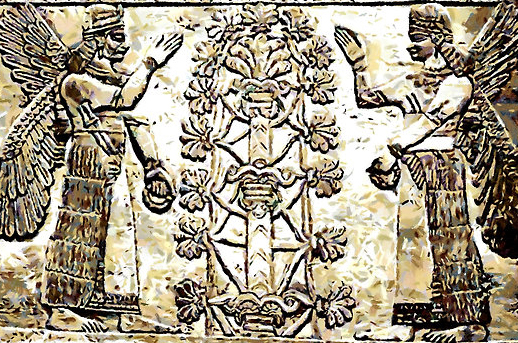
The Free Masons source the exoteric biblical tradition, Jacobs ladder at Luz, the Plan of the Temple of Solomon, the Tree of the Garden of Paradise, the rib of Eve, all adaptations, but following on from other adaptations which had been subjected to change, for example a spider changing into a winged disk.
I have read Mesopotamian Cosmic Geography but i think the stellar axis i outline here pre-dates any of that, being first represented some 5,200 years ago, that it didn't have much practical function and represents even at that time a fading tradition, two of the constellations i have needed to personally identify for the earliest period, Orion as the seated woman and Canis Major as the spider were soon replaced into the historic period, the paper were i sourced some of the images from has this to say;
Winged Disks and Sacred trees
It always seems to me though that in terms of myth quality tends to fade over time becoming ever less imaginative and ever more easy to interpret, with a lot of the star lore people just lost interest, a spider Goddess becomes something as boring as a bow and arrow just generally pointing in the right direction, the classical accounts in which people have attempted to source the mysteries are pretty dull, for the greater part of biblical symbolism all they're generally doing is hinting at and referencing earlier traditions, but of course people tend to find the duller version of their age more approachable and few care about the origin of specious.
I do consider the Hebrews to have had a long term interest in the basis for the Kabbalistic Tree of Life prior to it's teaching in the West because of their emphasis on Yah-Ea-Enki from the time of Ebla onwards, if they didn't have an adaptation from such important Enki mythos they would have been seriously slipping, but i don't believe they were and were fully conversant with the traditions, after all Babylon, 600 BC, the time of this representation, they were there.

The Free Masons source the exoteric biblical tradition, Jacobs ladder at Luz, the Plan of the Temple of Solomon, the Tree of the Garden of Paradise, the rib of Eve, all adaptations, but following on from other adaptations which had been subjected to change, for example a spider changing into a winged disk.
I have read Mesopotamian Cosmic Geography but i think the stellar axis i outline here pre-dates any of that, being first represented some 5,200 years ago, that it didn't have much practical function and represents even at that time a fading tradition, two of the constellations i have needed to personally identify for the earliest period, Orion as the seated woman and Canis Major as the spider were soon replaced into the historic period, the paper were i sourced some of the images from has this to say;
In his book The Prehistory of the Mind , Steven Mithen compares the development of the mind to the architectural plan of a cathedral “that may have been continually tinkered with, but no plan has ever started again from scratch.Evolution does not have the option of returning to the drawing board and beginning anew, it can only ever modify what has gone before.”
The same principle could be applied to some of the constructs created by the mind. No enduring political ideology or religious faith has yet been invented entirely from scratch.
Winged Disks and Sacred trees
It always seems to me though that in terms of myth quality tends to fade over time becoming ever less imaginative and ever more easy to interpret, with a lot of the star lore people just lost interest, a spider Goddess becomes something as boring as a bow and arrow just generally pointing in the right direction, the classical accounts in which people have attempted to source the mysteries are pretty dull, for the greater part of biblical symbolism all they're generally doing is hinting at and referencing earlier traditions, but of course people tend to find the duller version of their age more approachable and few care about the origin of specious.
originally posted by: Kantzveldt
I have read Mesopotamian Cosmic Geography but i think the stellar axis i outline here pre-dates any of that, being first represented some 5,200 years ago, that it didn't have much practical function and represents even at that time a fading tradition, two of the constellations i have needed to personally identify for the earliest period, Orion as the seated woman and Canis Major as the spider were soon replaced into the historic period, the paper were i sourced some of the images from has this to say;
Hmm? Horowitz begins from 3300bc.
The Steven Mithen book is excellent too, unlike Horowitz he interprets, sometimes overly, but great basis in data none the less.
a reply to: KilgoreTrout
I gave a conservative dating at 3,200 Bc, the Jemdet Nasr period seals i've been concerned with follow on from that, the greater point being that's the earliest period for seals and written tablets indicating astrological interest, that belief system itself could be considerably older it is simply the first time recorded.
That is the reason i expressed caution with regards to just shunting the Celestial axis symbolism for the Tree of Life into the general drawer of Babylonian systems of observation as found in the Mul Apin, it doesn't belong there as that was a systematic approach to create a grid like system of stars tracking across the horizons and defining the relative positions of astral objects within it.
In it's own way the earlier axis does have some indication of providing a means for a visual fix on the Heavens in general, taking the brightest star Sirius and then following' an axis through Orion's belt, but it's on a very much stand alone basis and can't be seen as a means to provide a basis for observation of Celestial mechanics.
I gave a conservative dating at 3,200 Bc, the Jemdet Nasr period seals i've been concerned with follow on from that, the greater point being that's the earliest period for seals and written tablets indicating astrological interest, that belief system itself could be considerably older it is simply the first time recorded.
That is the reason i expressed caution with regards to just shunting the Celestial axis symbolism for the Tree of Life into the general drawer of Babylonian systems of observation as found in the Mul Apin, it doesn't belong there as that was a systematic approach to create a grid like system of stars tracking across the horizons and defining the relative positions of astral objects within it.
In it's own way the earlier axis does have some indication of providing a means for a visual fix on the Heavens in general, taking the brightest star Sirius and then following' an axis through Orion's belt, but it's on a very much stand alone basis and can't be seen as a means to provide a basis for observation of Celestial mechanics.
edit on Kam831238vAmerica/ChicagoWednesday2731 by Kantzveldt because: (no reason given)
a reply to: eagle73over
It does not.
Off-hand, the only mention to stars I can think of in the entire ritual are references to:
- Seven stars in the First Degree lecture
- The Bright Morning Star
- The Blazing Star
- The moon and stars in Ecclesiastes
It does not.
Off-hand, the only mention to stars I can think of in the entire ritual are references to:
- Seven stars in the First Degree lecture
- The Bright Morning Star
- The Blazing Star
- The moon and stars in Ecclesiastes
originally posted by: Kantzveldt
So one begins to see a marked difference in the Sumerian associations with the Tree of Life and the teachings of the Kabbalah and it's claim to represent all aspects of Divinity through the eleven nodes and their mystical three way interpretation of the 33 Masonic Degrees,
Hmmm.....
Judaic mysticism is explored to some extent in the York Rite (The Holy Royal Arch Degree to be particular), but does not feature in the Scottish Rite which has the 33° numbering system at all. Not in English Masonry at least.
a reply to: eagle73over
The Blazing Star, which can be taken as Sirius, appears in these Degree's;
Blazing Star
The Blazing Star, which can be taken as Sirius, appears in these Degree's;
he Blazing Star, which is not, however, to be confounded with the Five-Pointed Star, is one of the most important symbols of Freemasonry, and makes its appearance in several of the Degrees. Hutchinson says "It is the first and most exalted object that demands our attention in the Lodge." It undoubtedly derives this importance, first, from the repeated use that is made of it as a Masonic emblem; and secondly, from its great antiquity as a symbol derived from older systems.
Extensive as has been the application of this symbol in the Masonic ceremonies, it is not surprising that there has been a great difference of opinion in relation to its true signification.
But this difference of opinion has been almost entirely confined to its use in the First Degree. In the higher Degrees, where there has been less opportunity of innovation, the uniformity of meaning attached to the Star has been carefully preserved.
In the Twenty-eighth Degree of the Ancient and Accepted Scottish Rite, the explanation given of the Blazing Star, is, that it is symbolic of a the Freemason, who, by perfecting himself in the way of truth, that is to say, by advancing in knowledge, becomes like a blazing star, shining with brilliancy in the midst of darkness. The star is, therefore, in this degree, a symbol of truth.
In the Fourth Degree of the same Rite, the star is again said to be a symbol of the light of Divine Providence pointing out the way of truth.
In the Ninth Degree this symbol is called the star of direction; and while it primitively alludes to an especia1 guidance given for a particular purpose expressed in the degree, it still retains, in a remoter sense, its usual signification as an emblem of Divine Providence guiding and directing the pilgrim in his journey through life.
Blazing Star
new topics
-
It’s Falling…
Philosophy and Metaphysics: 1 hours ago -
Steering the Titantic from the Drydock.
Rant: 4 hours ago
top topics
-
House Passes Laken Riley Act
Mainstream News: 16 hours ago, 24 flags -
Hearing more ambulances lately
Medical Issues & Conspiracies: 15 hours ago, 8 flags -
Steering the Titantic from the Drydock.
Rant: 4 hours ago, 8 flags -
Los Angeles brush fires latest: 2 blazes threaten structures, prompt evacuations
Mainstream News: 15 hours ago, 7 flags -
Paramilitary Leaks - John Williams
Whistle Blowers and Leaked Documents: 13 hours ago, 6 flags -
The more I think about it
General Chit Chat: 16 hours ago, 4 flags -
Some sausage, some chicken, some sauce, some onions and some garlic...and some peppers!
Food and Cooking: 14 hours ago, 3 flags -
It’s Falling…
Philosophy and Metaphysics: 1 hours ago, 2 flags
active topics
-
ILLUMINATION: Dimensions / Degrees – Da Vincis Last Supper And The Philosophers Stone
Secret Societies • 23 • : CarlLaFong -
Los Angeles brush fires latest: 2 blazes threaten structures, prompt evacuations
Mainstream News • 15 • : WeMustCare -
Steering the Titantic from the Drydock.
Rant • 15 • : lilzazz -
House Passes Laken Riley Act
Mainstream News • 18 • : Xtrozero -
A Complete List of All 149 MKULTRA Subprojects
General Conspiracies • 67 • : WeMustCare -
Post A Funny (T&C Friendly) Pic Part IV: The LOL awakens!
General Chit Chat • 8002 • : underpass61 -
The more I think about it
General Chit Chat • 6 • : chiefsmom -
Remember These Attacks When President Trump 2.0 Retribution-Justice Commences.
2024 Elections • 139 • : Oldcarpy2 -
Canada as a state .. how would it work?
General Chit Chat • 19 • : Freeborn -
It’s Falling…
Philosophy and Metaphysics • 0 • : JJproductions
